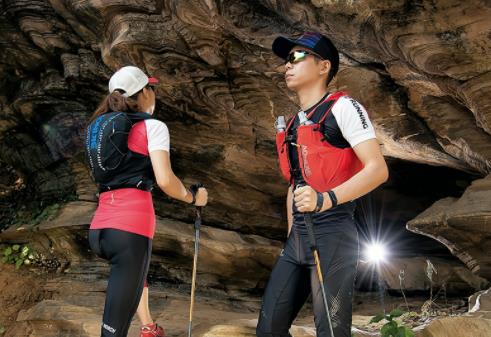
Weight:
There are two options to consider first. Do you want a more durable backpack that provides support with less stress and load on your back, or do you want a super lightweight backpack that loses support but gains less weight?
Popular consensus is that any backpack weighing more than 1.5 kg (3.3 LBS) is probably too heavy these days, and most high-tech running backpacks of this size are under 1 kg (2.2 LBS). Look for one made of a strong, lightweight material, such as polyester or rip-proof nylon. Also check the seams and zippers on the backpack to make sure they can withstand a certain amount of use and tear.
Now, as you lose weight at the expense of strength, it's important to note that running backpacks are not designed for heavy use over the years. This is where we talked about the difference between a running backpack and a training backpack, and we'll deal with that in a second.
Adding padding to the belt and shoulder straps will increase comfort and stability, but they also add weight to the overall backpack. If you have a weakness then determine where you need support. Do some long-distance training research with a backpack, and determine the appropriate belt adjustment, chest, and shoulder straps based on your body type and running posture. A small chest pocket can be added to many rucksacks, and some people find it more comfortable to split the weight between the front and back.
Conveniently accessible:
Side pockets and belt pockets allow you to get the necessary food replenishment (energy bars, gel, snacks, electrolytes, etc.) without having to remove your backpack. This is very important when you are in the middle of a race because you need to recharge quickly. Chest pockets can be snug to the body if extra supplies must be easily accessible, and you'll find them comfortable. The water bottle carrier attached to the shoulder straps is another thing to consider, as easy access to water is key, and if you plan to get past the checkpoint quickly, the water bottle fills up faster than a drinking device in a backpack.
Training knapsack:
Of course you'll need to carry your running pack on your back a few times to make sure it fits comfortably for the long runs you intend to complete. It is ideal to do this once or twice a week in the two months leading up to the competition. However, if you want to do a lot of training with a backpack and you also decide to use a very lightweight running backpack, using a running backpack for a long workout may not be the best idea. The super-lightweight backpack is not designed for long-term durability, and you don't want to spoil the material or seams before a race. You should make the most of your training pack in this case. A training pack can be slightly heavier than your race pack and is more durable because you won't be carrying it for a 250km race. Or you can simply buy two identical race packs, one for training and one for racing.
Training:
Many runners train with rice bags in their backpacks because the weight is easy to adjust and it's comfortable. Many other things can also be used to control weight, including textbooks, water bottles, etc. However, a bag of 3-5 kg of rice (or other items) falling on the bottom of your backpack will crack the seams of any good quality lightweight model during years of training and put pressure on the material, especially when you're running.
To make it more realistic to carry your backpack, you need to spread the weight around the backpack. One way to do this is to simply place some towels at the bottom of your backpack and place rice sacks (or other items) on top of the towel. This way the weight will rise a little bit in your backpack and become more centered.
PS: Do you have any back skin wear due to the friction of the backpack not fitting? Please try adding another layer of clothing, it should solve your problem.
 Zhejiang Aonijie Outdoor Products Co. Ltd.
Zhejiang Aonijie Outdoor Products Co. Ltd.
